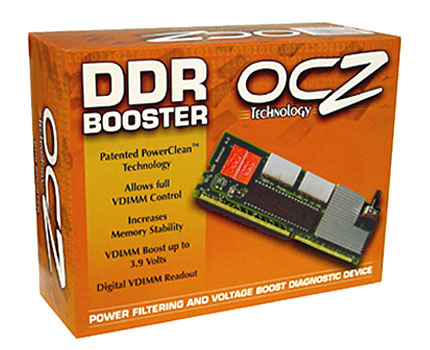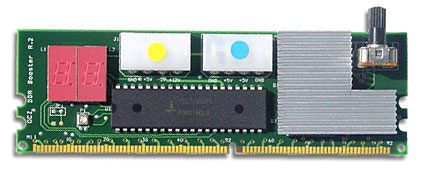OCZ VX Memory + DFI nForce4 = DDR533 at 2-2-2
by Wesley Fink on March 4, 2005 6:45 AM EST- Posted in
- Memory
OCZ EL PC4000 VX Gold
OCZ has developed quite a reputation in the past year with the introduction of many leading-edge memory products. As you will see in a look at our ongoing memory benchmarks, the results have been that OCZ owns many of the top performance spots in our memory tests. Even with that kind of reputation, OCZ VX must be counted a unique product. The EL label is used by OCZ for Extreme Latency, but VX is a new label used to refer to Voltage eXtreme memory. VX means that the memory is designed for and can handle very high memory voltages for expanded performance.The first OCZ VX memory was rated at a very conservative PC3200 2-3-3-8 at a standard 2.6V. While it met these specifications, the specs hardly described a memory that was widely recognized as capable of DDR500 and higher at 2-2-2 timings using voltages of 3.0V and higher. As yields and binning improved, OCZ decided in late February to introduce an updated VX memory - now rated at DDR500 2-2-2 at 3.3V.
The new DDR500 2-2-2 uses the same chips as the earlier VX, but it is binned for higher speed and verified at the new DDR500 specifications. OCZ tells us that everything about the new VX memory is basically the same as earlier PC3200VX, but with even better chips becoming available for VX, it was time for the higher speed rating. OCZ will also be introducing a VX value memory in the future for those enthusiasts that want 2-2-2 timings, but do not demand DDR500+ timings for 2-2-2. Gold VX modules are optimized for use on Athlon 64 based motherboards. In addition, OCZ EL PC-4000 Gold VX is rated to handle up to 3.5V without invalidating the OCZ lifetime warranty.

The new VX DDR500 uses the familiar OCZ Gold heatspreaders. OCZ describes the heatspreaders as gold-mirrored copper, and DDR500 VX is only available as a 1GB kit with two 512MB double-sided memory modules. We removed the heatspreader and found the memory chips were labeled OCZ. OCZ apparently buys memory chip blanks and relabels them for VX. OCZ is usually very open about chip sources, but in this case, they would only comment that the memory chips were made to their specifications and went through extensive binning at OCZ. Forums are claiming that the blank is a new Winbond memory chip.
The recently tested DFI LANParty nForce4 boards are the only current production boards to fully support the voltages required by VX memory. It is fortunate that the DFI are also excellent performers and the DFI LANParty nF4 SLI-DR was the recent winner of our Gold Editors Choice in the nForce4 SLI roundup. The DFI boards are only recently available, however, and prior to the DFIs, there were two ways to use VX memory. First, some enthusiasts modified their boards to supply higher memory voltage.

Second, you could use VX with an OCZ DDR Booster, which is a device designed to fit into the DIMM slot of most motherboards.

The DDR Booster is a little $40 device that allows the user to select voltages up to 3.9V regardless of what voltages the motherboard supports. This neatly gets around the fact that most motherboards supply only 2.7V to 2.85V to the memory slots. For motherboards other than the DFI, you can even buy a bundle of VX memory with the DDR booster.
OCZ EL PC4000 VX Gold Specifications
| OCZ EL PC4000 VX Gold Memory Specifications | |
| Number of DIMMs & Banks | 2 DS |
| DIMM Size Total Memory |
512 MB |
| Rated Timings | 2-2-2-8 at DDR500 at 3.3V 2-3-3-8 at DDR400 at 2.6V (Typically 2-2-2-8 at DDR400 at 3.0V) |
| SPD (Auto) Timings | 3-3-3-8 |
| Rated Voltage | 3.3V |
With Intel's introduction last summer of the Intel 915/925X chipsets with support for DDR2 memory, the primary market for DDR memory has become the excellent AMD Athlon 64 platform. However, some 915 boards also support DDR, and the continuing Intel Socket 478 also supports DDR memory. It is worth noting that OCZ designed PC4000VX for the AMD platform and it is optimized for the Athlon 64 platform. In addition, the only unmodified motherboard for VX is the DFI nForce4 motherboards. For these reasons, OCZ EL PC4000 VX Gold was only tested on the DFI LANParty nF4 SLI-DR Athlon 64 Socket 939 test bed.










67 Comments
View All Comments
Lymphatik - Wednesday, March 30, 2005 - link
Hi I would like to know if u think that thoose dimms could be enough cooled by a 120 mm fan in extraction and a 120 mm fan from a power suplyBecause i would like to put thoose dimm in antec Sonata and as it's a small case i don't know if i will have enough space to put a fan
Lymphatik - Wednesday, March 30, 2005 - link
OCedHrt - Thursday, March 24, 2005 - link
Figured it out, seems like the cpu speed plays a role here. 2.25 ghz maxes out at 6600-6700. 2.34 gets 6900-7000. I wonder if going even higher will set a new bandwidth record.OCedHrt - Tuesday, March 22, 2005 - link
Hmm, I can't seem to duplicate the results here and I don't know what I'm doing wrong. I have 2 sticks of pc3200 ocz vx and a dfi ultra (non-sli). I have the ram running at ddr500 at 2-2-6-2 T1 @3.3v and sandra reports a bandwidth of 6000-6100. The weird part is that sandra reports a timing of 2T but if I drop the timing from 1T to 2T in the bios, the results drop to 5700 so I'm pretty sure 1T is enabled. Any ideas?zumbi9in - Saturday, March 19, 2005 - link
I would like you to help me with a MotherBoard/RAM question.I’m about to buy a DFI Lanparty NFORCE 4 Ultra MB with 2 GB of RAM.
This machine will be for audio sampling and recording, and some gaming too J
I’m worried if it can run 2 GB of RAM at DDR400, I don’t know if it will drop the memory speed with this config.
I would like to buy 4x512 KINGSTON PC3200 ULTRA LL 2-2-2-5, but as they are double sided, maybe they will run at DDR333
The 2nd option would be 2x1024 of OCZ memory PC 3200 3-3-3-7 OCZ4001024PF, is its performance good with this latency?
I have searched lots of forums and didn’t find a final word about this issue.
What would be the best performance choice? Do you think it can work?
Thank you very much,
Alexandre Zumbi.
Rand - Wednesday, March 9, 2005 - link
ozzimark - Wednesday, March 9, 2005 - link
#60-iirc, the dfi was tuned for tccd and bh-5/vx.
other stuff that overclocks somewhat does terribly on the dfi, that includes ballistix's micron 5b-g chips.
L3p3rM355i4h - Wednesday, March 9, 2005 - link
hmm...good performance, but also a lot of questions. How well does ballistix do on the mobo?Quanticles - Wednesday, March 9, 2005 - link
For everyone hung up on the on-board memory controller...The motherboard will make a difference for the on-board memory controller, not because of the chipset, but due to the characteristics of the routing. The type of material used, the thickness and width of the copper traces, and how well the traces are matched in length, will all make a huge difference in signal integrity. Even differences in what layers of the board you route to make a difference, and what power plains they're coupled against are. The list goes on...
DFI put a lot more effort into their routing, and it makes a significant difference.
slashbinslashbash - Tuesday, March 8, 2005 - link
#56 - Wow. Thanks for pointing this out. This review is bogus. I hope that you cc'd Mr. Shimpi on that e-mail.